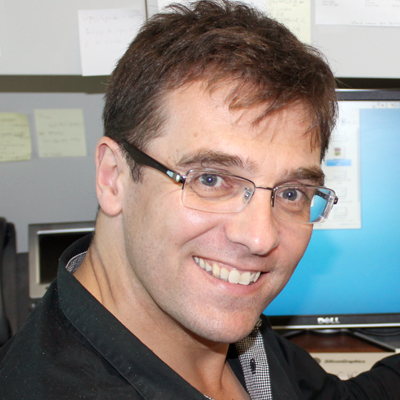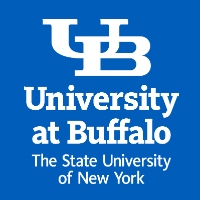Using theoretical chemistry to investigate molecular structures and chemical bonding, and how they relate to the desired functionality of a synthesized molecule
Theoretical chemistry is playing an increasingly crucial role in the development of new drugs, new chemical catalysts, and new molecular materials. Theory can even predict new molecules with desired properties that ought to be synthesized. Dr. Jochen Autschbach uses theory and computer simulations to understand how molecular structures (the 'shapes' of a molecule) and chemical bonding determine what can be observed in the laboratory for a variety of chemical compounds. When data is limited or experimentation is very difficult - as it often is - theory provides an ideal alternative way for gaining insight into new compounds. Dr. Autschbach's research focuses on how the basics of chemistry connect to later discovery and outcomes. It strengthens the scientific software infrastructure and contributes to society by identifying and improving chemical catalysts used to make plastics and other types of polymer materials, by joining efforts with nuclear waste clean-up, and by identifying potentially harmful molecular variants of drug molecule candidates.
Dr. Jochen Autschbach, Professor in the Department of Chemistry at the University of Buffalo, State University of New York, is working with quantum theory, which predicts accurately what electrons and atomic nuclei do in molecules. He is predicting optical and "spectroscopic" properties of molecules and molecular materials, and understanding how these properties relate to molecular structures and chemical bonding. This data is critical for the rational design of new molecules and, for existing compounds, to know why laboratory observations return the results that they do. In spectroscopy, electric or magnetic fields of varying frequency are used for detecting how a molecule responds to the presence of either static or oscillating fields. These spectroscopic methods are the most powerful tools available to scientists for investigating molecular structures, bonding within molecules, interactions between molecules, and how all of this relates to the desired functionality and chemical behavior of a synthesized compound. For instance, if a group of scientists synthesize a new molecule, they will need to know its structure and how the atoms in it bond to one another by using spectroscopy. This can also work in reverse. If Dr. Autschbach and his team find interesting properties relating to a molecule, they can encourage an experimentalist to try the measurement or even synthesize the molecule if it does not yet exist.
Dr. Autschbach approaches chemistry through theory and by running simulations on molecules. Current research examines organo-metallic complexes that serve in polymer catalysis, magnetic properties of heavy metals that occur in nuclear waste, and optical properties of biomolecules and drug molecules.
-
Some organo-metallic complexes, or organic (natural or synthetic) compounds surrounding a metal atom core, are great catalysts for polymer production in making plastics. Unfortunately, good structural information for these compounds in their catalytically active form is very hard to come by. Catalysis usually occurs at the metal atom center, so knowing what surrounds the metal and what kinds of bonds are around it will provide valuable insight into its catalytic capabilities. Spectroscopic experiments can be performed in order to identify molecular structures and bonding properties once there are reliable predictions from theory, which will improve the compound's use as a catalyst. The plastics industry, especially high-performance modern polymers, is a multi-billion dollar industry with many vested manufacturing interests. Detailed knowledge about the catalysts used in polymer production discovered through theory has the potential to improve their efficiency vastly without the trouble of running many trial and error experiments.
-
In areas like the Hanford Site in Washington, radioactive waste tanks have been storing nuclear waste for many decades. Over time, compounds have been reacting with one another to form a slew of known and unknown compounds. Many of them contain heavy radioactive metals. In collaboration with experimental scientists, Dr. Autschbach is using theory to determine magnetic properties of compounds with such heavy metals. Experiments based on these magnetic properties may either confirm or refute what compounds scientists believe to be in these tanks. For example, a scientist may present a possible molecule and ask Dr. Autschbach to run calculations on their data. Based on his models, Dr. Autschbach can confirm that the measurements match the calculations or refute the scientist's findings based on a discrepancy between the measurements and his calculations, potentially offering an alternative solution. Experimentation is limited by an extremely small quantity of sample material and radioactive hazard, so theory is absolutely vital in identifying these compounds. This information helps environmentalists and scientists determine the pathways by which these toxic and radioactive elements leak into our environment, and the most appropriate methods to correct it.
- Most biomolecules, those naturally occurring in organisms like nucleic or amino acids, sugars, synthetic drug molecules, like the active ingredient in Advil and Motrin, and many catalysts used to make new drugs have a property called "handedness." These molecules come in pairs, like your left (L) and right (R) hand. The two forms share many chemical and physical properties, yet they are quite distinct from one another. They have unique optical properties related to this handedness, called "optical activity," that Dr. Autschbach studies extensively using computations. When observed, optical activity has opposite signs for the opposite molecular "hands" L and R. This provides a great way, for example, to know if a chemical synthesis has produced L or R: Calculate the optical activity for one of them and compare with experiment. The sign matches or it is opposite. Either way, one knows if the experimental compound was L or R. Handedness is important because often times only one variant of a molecule has beneficial effects, while the other does not; it can be either harmless or disastrous. However, it is usually much easier and cheaper to synthesize a 50/50 mixture. In the case of Thalidomide, a drug marketed in 1957 by a West German pharmaceutical company to alleviate morning sickness in pregnant women, the use of a 50/50 mixture had devastating consequences. The therapeutically inactive form of the drug resulted in thousands of babies worldwide being born with malformation of the limbs, of which only about half survived. This disaster accentuates the importance of understanding the handedness and optical activity of molecules.
Bio
Dr. Autschbach wanted to become a chemist since he was five years old, when his older brothers Peter and Frank were given chemistry sets. He was fascinated by the colors and smells of the chemicals and the intriguing shapes of the glassware. One day when nobody was watching, he took a sip from one of Peter's test tubes, which contained a beautiful blue copper sulfate solution. Fortunately, he was not poisoned since copper salt solutions induce violent vomiting, but despite the awful taste he was hooked on science. Perhaps the experience led him to become a theoretical chemist, which uses computers, program code, and quantum theory, but no actual chemicals.
Nonetheless, Dr. Autschbach studied chemistry in his hometown of Siegen, a small city close to Cologne in what was then called Western Germany. Initially he wanted to become a biochemist, but the curriculum in Siegen was unusual, having students take theoretical chemistry courses in only their second year. Because he served 18 months of civil service upon completing high school, Dr. Autschbach entered university in the spring semester, rather than the fall, and thus took his first theoretical chemistry lectures after only the first semester. The instructor was great, and the topics (molecular symmetry, quantum theory of chemical bonding, etc.) were fascinating. Despite the lectures being at 8 a.m., Dr. Autschbach looked forward to every one, continuing in years two and three with several more theory courses. By this time he had decided that he wanted to become a theoretical chemist and pursue an academic career. Interestingly enough, his theoretical chemistry instructor from year one eventually became his Ph.D. advisor.
While Dr. Autschbach was an undergraduate and graduate student, a lack of accuracy in molecular calculations led many in the chemistry department to adopt the opinion that "a research group should have a theoretician, but ultimately quantum chemistry was useless." How this has changed in the past two decades! Most high-profile publications in chemistry now feature a combination of theory and experiments, and the research has benefited tremendously from this collaboration. This change is due partly to theoretical developments but also the massive increase in computational power and speed, allowing for accurate theoretical predictions for molecules of real-life interest.
In the News
UB Reporter


